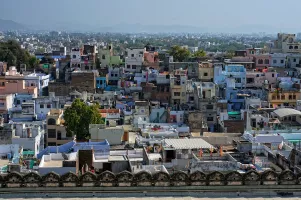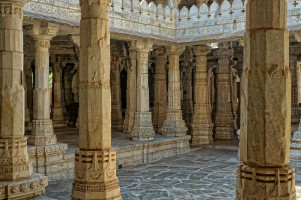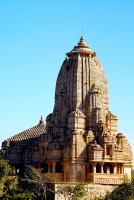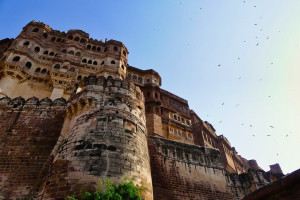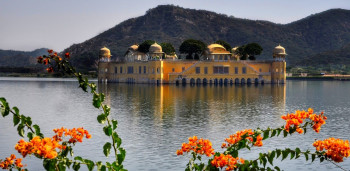Kumbhalgarh Wildlife Sanctuary
Duration
2 to 4 Days
2 to 4 Days
Best time to visit
Oct-Mar
Oct-Mar
Theme
Wildlife
Wildlife
Kumbhalgarh Wildlife Sanctuary Travel Guide
Kumbhalgarh Wildlife Sanctuary, located in the rugged Aravalli Hills of Rajasthan, India, is a paradise for nature lovers and wildlife enthusiasts. The sanctuary is not only known for its diverse flora and fauna but also for its historical significance, with the majestic Kumbhalgarh Fort standing tall within its boundaries. This UNESCO World Heritage Site is famous for being home to the second-largest wall in the world, after the Great Wall of China. The sanctuary offers a unique blend of history, culture, and natural beauty that attracts visitors from all over the globe.Top Attractions in Kumbhalgarh Wildlife Sanctuary
- Jeep Safari to spot leopards, sloth bears, and various bird species
- Visit Kumbhalgarh Fort for panoramic views of the surrounding countryside
- Trekking and nature walks to explore the diverse ecosystem of the sanctuary
- Explore the Badal Mahal, a beautiful palace inside the fort with intricate designs
- Experience the Kumbhalgarh Festival showcasing local culture, music, and dance
Kumbhalgarh Wildlife Sanctuary is Famous for
Its sprawling wildlife sanctuary and the stunning Kumbhalgarh Fort.Top Attractions in Kumbhalgarh Wildlife Sanctuary
- Jeep Safari to spot leopards, sloth bears, and various bird species
- Visit Kumbhalgarh Fort for panoramic views of the surrounding countryside
- Trekking and nature walks to explore the diverse ecosystem of the sanctuary
- Explore the Badal Mahal, a beautiful palace inside the fort with intricate designs
- Experience the Kumbhalgarh Festival showcasing local culture, music, and dance
What's Great about Travelling to Kumbhalgarh Wildlife Sanctuary?
- Perfect destination for wildlife enthusiasts and nature lovers
- Rich historical and cultural heritage to explore
- Breathtaking landscapes and scenic views
What's Not So Great about Travelling to Kumbhalgarh Wildlife Sanctuary?
- Limited accommodation options within the sanctuary
- Remote location may require some extra travel time
- Weather can be extreme during certain months
Travel Tips for Kumbhalgarh Wildlife Sanctuary
- Obtain necessary permits for entry into the sanctuary
- Wear comfortable clothing and sturdy shoes for trekking
- Carry sufficient water and snacks during your wildlife excursions
Important Kumbhalgarh Wildlife Sanctuary trip information
- Ideal Duration: 2-3 days to explore the sanctuary and fort
- Best Time to Visit: October to March for pleasant weather
- Nearby Airports and Railway Stations: Udaipur Airport (90 km) and Falna Railway Station (80 km) provide easy access
Total
35,000
*EXCLUDING APPLICABLE TAXES 4.1 Ratings
( 56 Reviews )
( 56 Reviews )
Per Person
9,900
*EXCLUDING APPLICABLE TAXES 4.1 Ratings
( 56 Reviews )
( 56 Reviews )
Per Person
21,546
*EXCLUDING APPLICABLE TAXES 4.9 Ratings
( 200 Reviews )
( 200 Reviews )
Per Person
21,025
*EXCLUDING APPLICABLE TAXES Per Person
13,408
*EXCLUDING APPLICABLE TAXES 4.9 Ratings
( 200 Reviews )
( 200 Reviews )
Per Person
18,714
*EXCLUDING APPLICABLE TAXES 4.9 Ratings
( 200 Reviews )
( 200 Reviews )
FAQ's on Kumbhalgarh Wildlife Sanctuary
Q1: What is the best time to visit Kumbhalgarh Wildlife Sanctuary?
The best time to visit Kumbhalgarh Wildlife Sanctuary is during the winter months from October to March when the weather is pleasant for exploring the sanctuary. This time also coincides with the peak tourist season and various events and festivals in the region.
Q2: Do I need a visa to travel to Kumbhalgarh Wildlife Sanctuary?
As Kumbhalgarh Wildlife Sanctuary is located in India, most tourists will need a tourist visa to visit. It's advisable to check with the nearest Indian embassy or consulate for specific visa requirements based on your nationality.
Q3: What are the must-visit attractions in Kumbhalgarh Wildlife Sanctuary?
The must-visit attractions in Kumbhalgarh Wildlife Sanctuary include the Kumbhalgarh Fort, Badal Mahal, Neelkanth Mahadev Temple, various wildlife safaris, and the scenic beauty of the Aravalli Range.
Q4: Is Kumbhalgarh Wildlife Sanctuary a safe place to travel?
Kumbhalgarh Wildlife Sanctuary is generally safe for tourists. However, it's recommended to be cautious in remote areas, follow local guidelines, and avoid venturing into the sanctuary alone, especially during early mornings or late evenings.
Q5: What is the local currency in Kumbhalgarh Wildlife Sanctuary and can I use credit cards?
The local currency in India is the Indian Rupee (INR). While credit cards are accepted at some hotels and restaurants in popular tourist areas, it's advisable to carry cash for smaller establishments and local markets. ATMs are also available in nearby towns for cash withdrawals.
Q6: What is the local cuisine like in Kumbhalgarh Wildlife Sanctuary?
The local cuisine in Kumbhalgarh Wildlife Sanctuary offers a variety of Rajasthani dishes like Dal Baati Churma, Gatte ki Sabzi, and Ker Sangri. Vegetarian options are prevalent, and travelers with dietary restrictions can find suitable alternatives.
Q7: What transportation options are available in Kumbhalgarh Wildlife Sanctuary?
Transportation options in Kumbhalgarh Wildlife Sanctuary include taxis, auto-rickshaws, and rental cars for exploring the area. Public buses are available from nearby cities like Udaipur and Ranakpur for those traveling on a budget.
Q8: Are there any cultural norms or etiquette I should be aware of when visiting Kumbhalgarh Wildlife Sanctuary?
When visiting Kumbhalgarh Wildlife Sanctuary, it's important to respect local customs such as dressing modestly, removing shoes before entering temples, and seeking permission before taking photographs of locals. Additionally, it's customary to greet people with a "Namaste" and show respect for religious sites and traditions.
Q9: I am a travel agent. How can I buy travel leads of Kumbhalgarh Wildlife Sanctuary?
Register yourself as a travel agent at agents.tripclap.com and then you can buy travel leads to Kumbhalgarh Wildlife Sanctuary once your account is approved. For more details contact our support team at +91-8069186564 or support@tripclap.com
